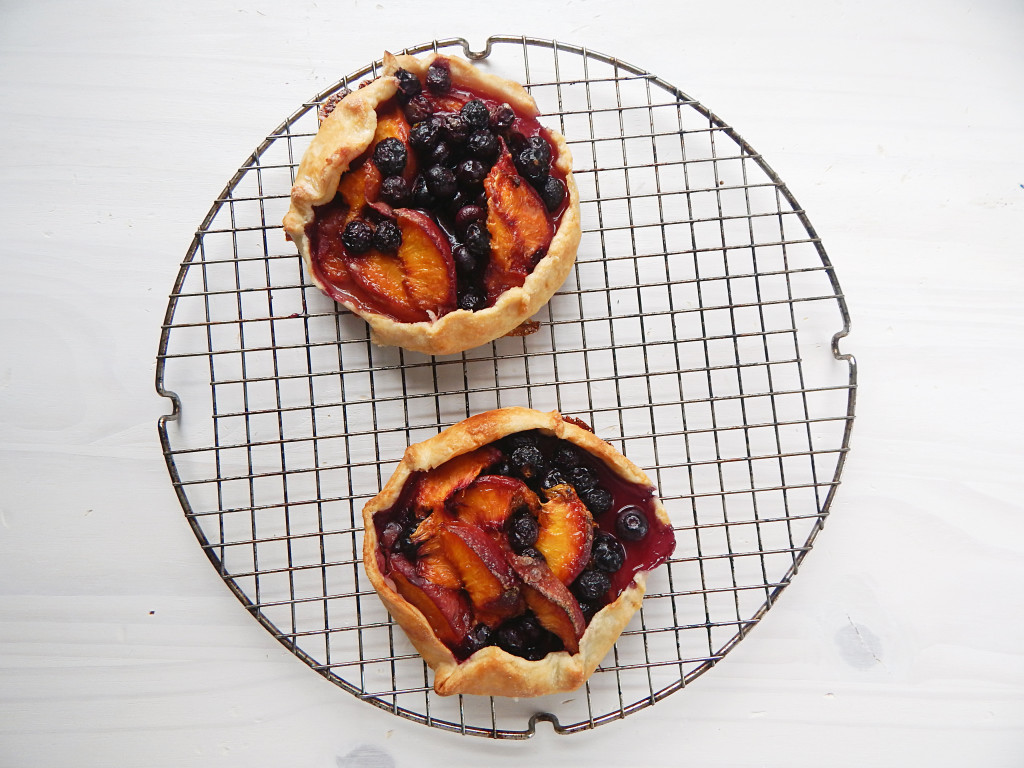Rustic Free-Form Tartlets for Two

I love summer fruit pies but making a whole pie for just two people is just too much not to mention the pie crust takes time. This simple free-form tartlet is a great alternative to pie.
I wanted a flaky crust so I learned a new technique called fraisage, in which the dough is smeared with the heel of your hand, spreading the butter pieces into long, thin streaks between layers of flour and water. This technique is perfect for free-form tarts where leaking might be a concern. Because you are creating alternating layers of butter and dough, you are less likely to get a clump of butter that will melt during baking and form a hole in your crust as it bakes.
The dough is then lifted up and back over the fruit leaving the center exposed, and loosely pleated. The fruit needs only the simple addition of sugar, 3 to 5 tablespoons depending on the type of fruit.
Some of the best mix of fruits are stone fruits and berries (I’m using peaches and blueberries but plum and raspberries or apricots and blackberries would be delicious too), you can use only one type of fruit if you prefer. Peeling the stone fruit, even the peaches, is not necessary.
Taste the fruit before adding sugar to it; use the lesser amount if the fruit is very sweet, more if it is tart. Be sure not to add the sugar to the fruit until you are ready to fill and form the tart, the sugar releases the juice in the fruit and you’ll end up with a soggy crust if done too soon.
Once baked, the tartlets are best eaten warm, or within 3 or 4 hours, although you can reheat them in a 350-degree oven. Don’t forget to add a scoop of vanilla ice cream…heaven!


- 3/4 cups unbleached all-purpose flour (3 3/4 ounces), plus additional for work surface
- 1/4 teaspoon table salt
- 5 tablespoons unsalted butter, cold, cut into 1/2-inch cubes
- 1 - 3 tablespoons ice-cold water
- 2 medium peaches
- 1/2 cup blueberries
- 2 - 4 tablespoons granulated sugar
- 1/2 tablespoon granulated sugar for sprinkling
- In a food processor, pulse the flour and salt to combine, about three 1-second pulses. Scatter the butter pieces over the flour, then pulse until the texture resembles coarse bread crumbs and the butter pieces are about the size of small peas, eight 1-second pulses. Sprinkle 1 tablespoon water over the mixture and process for two pulses; repeat using 1 teaspoon at a time until dough begins to form small curds and holds together when pinched with fingers. Empty dough onto your work surface; dough will be crumbly (if the dough has large dry areas, sprinkle additional 1 teaspoon water over dry areas and incorporate by gently fluffing entire amount of dough with fingers). Using bench scraper, gather dough into rough mound about 6 inches long and 2 inches wide (mound should be perpendicular to edge of counter). Beginning from farthest end, use the heel of your hand to smear about one third of dough against work surface away from you. Repeat until all the dough has been worked. Using the bench scraper, gather dough again and repeat. Dough should now be cohesive. Form dough into 3-inch disk, wrap in plastic, and refrigerate until cold and firm but malleable, about 1 hour.
- During the last 30 minutes of chilling, prepare fruit. Halve and pit stone fruit and cut into 1/2-inch-thick wedges. Gently wash and dry the berries and combine the fruit in medium bowl (you should have about 3 cups); set aside. Adjust oven rack to lower-middle position and heat oven to 400 degrees.
- (If dough has chilled longer than 1 hour and is cold and hard, let stand at room temperature 15 to 20 minutes before proceeding.) Divide dough into 2 equal portions. On a large sheet of parchment paper lightly dusted with flour, roll each dough portion into 7 inch round about 3/16 inch thick, dusting with flour as needed. If the dough sticks to parchment, gently loosen and lift sticky area with bench scraper and dust parchment with additional flour. Stack rounds and refrigerate until cool and firm but still pliable, 15 to 30 minutes If refrigerated longer and dough is hard and brittle, let stand at room temperature until pliant.
- Sprinkle fruit with sugar and toss gently to combine. Remove the dough rounds from refrigerator. Mound one half of fruit in center of each dough round, leaving 1 1/2-inch border around edge. Carefully grasp one edge of dough and fold up outer 1 to 1 1/4 inches over fruit, leaving 1/4-inch area of dough just inside of fold free of fruit. Repeat around circumference of tart, overlapping dough every 2 to 3 inches; gently pinch pleat dough to secure, but do not press dough into fruit. Transfer parchment with tart to rimmed baking sheet. Repeat with remaining fruit and dough. Brush the dough with water and sprinkle each tartlet with remaining 1/2 tablespoon sugar. Bake until deep golden brown and fruit is bubbling, 40 to 45 minutes. Cool tartlets on wire rack 10 minutes. Using a wide metal spatula, loosen tartlets from parchment and transfer to a wire rack and cool until warm for about 20 minutes, or to room temperature.
- The amount of water that the dough will require depends on the humidity; in a dry environment, it may need more water, in a humid environment, less. The dough can be made ahead and refrigerated overnight or tightly wrapped in two sheets of plastic wrap and frozen for up to one week. If at any point the dough becomes soft, sticky, and difficult to work with during rolling, chill it until it becomes workable.













